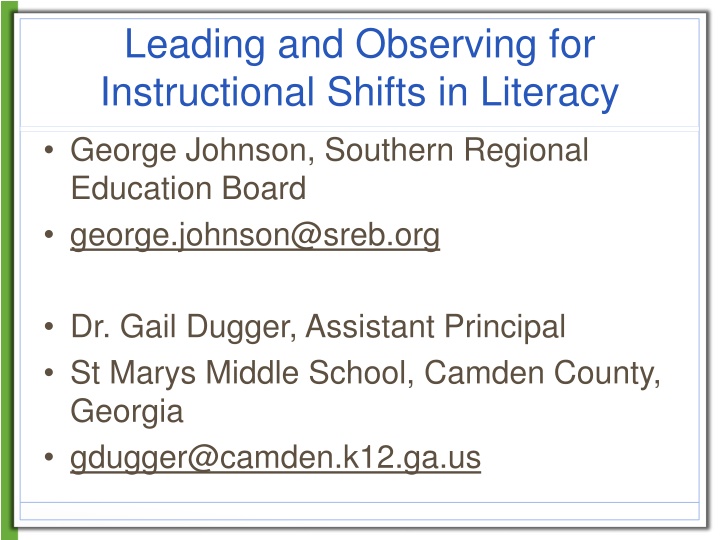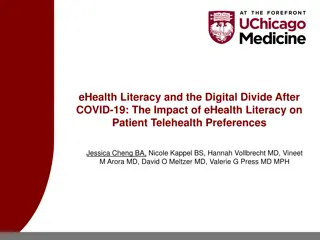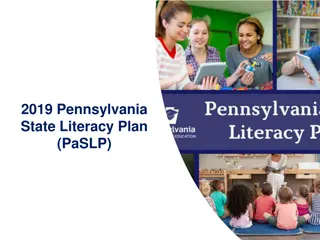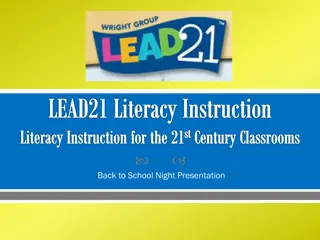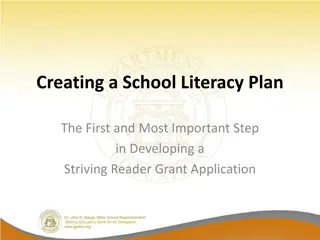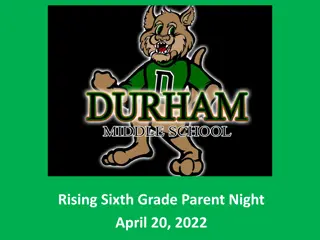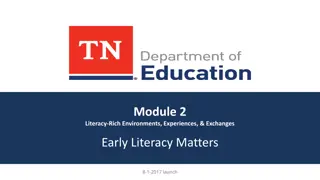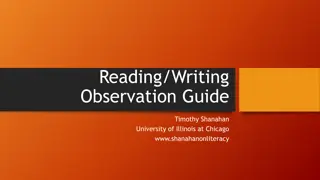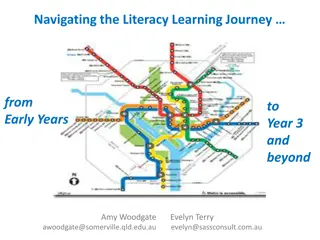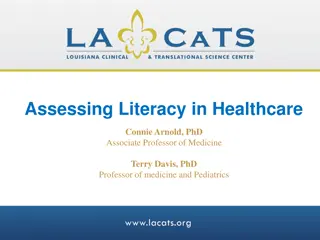Transforming Literacy Instruction at St. Marys Middle School
St. Marys Middle School in Camden County, Georgia, embarked on a collaborative partnership with the Southern Regional Education Board to enhance literacy instruction. Prior to the implementation of the Literacy Design Collaborative (LDC), teachers primarily focused on literary elements and limited writing tasks. However, with the shift to LDC, the school aimed to engage students in complex texts, align assignments with College and Career Readiness Standards, personalize learning, and ensure all students are college and career ready. The transformation also extended to science and social studies classes where teachers shifted from traditional instruction to more interactive and student-centered approaches.
Download Presentation

Please find below an Image/Link to download the presentation.
The content on the website is provided AS IS for your information and personal use only. It may not be sold, licensed, or shared on other websites without obtaining consent from the author.If you encounter any issues during the download, it is possible that the publisher has removed the file from their server.
You are allowed to download the files provided on this website for personal or commercial use, subject to the condition that they are used lawfully. All files are the property of their respective owners.
The content on the website is provided AS IS for your information and personal use only. It may not be sold, licensed, or shared on other websites without obtaining consent from the author.
E N D
Presentation Transcript
Leading and Observing for Instructional Shifts in Literacy George Johnson, Southern Regional Education Board george.johnson@sreb.org Dr. Gail Dugger, Assistant Principal St Marys Middle School, Camden County, Georgia gdugger@camden.k12.ga.us
Goals of LDC To engage students in reading, comprehending, analyzing, interpreting, and responding to complex texts To align assignments to the College and Career Readiness Standards and to promote collaboration To help teachers personalize learning so that every student can master the CCRS To ensure that all students can be college and career ready To improve literacy instruction in all classes
St. Marys Middle School Camden County , Georgia
THE SREB AND SMMS COLLABORATIVE PARTNERSHIP Creation of School Improvement Focus Teams LDC MDC Problem-Based Learning STEM curriculum: Seeking State STEM Certification
SMMS BEFORE GSE/LDC IN ELA Teachers: Focused on a single text with a focus on literary Assigned mostly shorter response writings Required persuasive rather than argumentative writing Based writing on prompts rather than a response to reading Students: Viewed writing as a Language Arts only activity Read few informational texts Wrote mostly about literary elements
SMMS BEFORE LDC SCIENCE/SOCIAL STUDIES Teachers: Wrote lesson plans as a series of activities based on a single text Assigned a limited number of short writing tasks Delivered predominantly whole-class instruction, lecture, note taking, testing Conducted whole-group discussion that focused on Q&A around knowledge and recall of facts Students: Sat in rows and completed individual seatwork Engaged in learning activities based on text questions and responding to teacher questions Became passive learners Responded only to the teacher s questions Completed few, if any written work in content area classes Participated in limited classroom discussions
LDC: Literacy Design Collaborative Training and Coach-embedded classroom visits: Year 1: ELA Teachers Year 2: Science, Social Studies Teachers, Sp. Ed. Teachers Year 3: LDC embedded in PBL and STEM units
SMMS AFTER GSE/LDC: ELA Teachers: Design scaffolded learning modules based on writing as a response to reading Generate writing prompts that address paired and multiple texts Build activities that foster independent learning Create structured paired or group activities allowing more time to focus on individual student needs Develop lessons required meaningful questioning and discussion (such as Socratic seminar) Students: Work in collaborative teams Engage in active learning activities Respond to informational texts in both argumentative and expository formats Engage in independent learning Create authentic written work in response to authentic texts Engage in meaningful discussions about their work
SMMS AFTER LDC: SCIENCE/SOCIAL STUDIES Teachers: Design scaffolded learning modules to build on students understanding of reading Generate writing prompts that are authentic to the content area Build in activities that foster independent learning and exploration of content Assign more complex informational texts and are less reliant on course textbooks Create structured paired or group activities, allowing more time to focus on individual student needs Students: Work in collaborative teams Engage in active learning activities Become independent learners Take greater responsibility for their learning Create authentic written work in the subject area Engage in meaningful discussions about content centered around student work
Grade/Subject 2015 2016 Gain Year- Year Gain Cohort ELA 6 39 44 +5 -- 7 38 40 +2 +1 8 43 48 +5 +10 Science 6 39 40 +1 -- 7 44 47 +3 +8 8 40 34 -6 -10 Social Studies 6 39 44 +5 -- 7 44 50 +6 +11 8 28 37 +9 -7 Georgia Milestones EOG Comparisons: Percentage Students Proficient and Distinguished 2015 to 2016
How do you know its working? (Regularly and Continuously) Pre- and Post-assessments in writing? Standardized Testing? Teacher Surveys? Observe Student and Teacher Behaviors in the classroom to identify the shifts in literacy instruction?
3 Questions you expect teachers to answer when they teach a lesson: 1. What do you want the students to____? learn 2. What are the students doing to show that they are _____? learning 3. How do you know that the students have__? learned
How do teachers move From: The teacher: Provides written questions from teacher/text to demonstrate understanding. To: The teacher: Allows students the opportunity to apply the appropriate literacy strategies to learn content and successfully complete the assignment.
How do students move From: The students: Respond to teacher s questioning; memorize facts; copy notes. To: The students: Generate higher-order questions as part of the collaborative learning process leading towards completion of the assignment.
Essential Behaviors When Using LDC 1. Essential Planning for Literacy-Based Instruction 2. Preparing for the Task: Launching the Assignment 3. The Reading Process 4. Transition to Writing 5. The Writing Process 6. Using Rubrics as Instructional Tools 7. Using Rubrics for PLC Collaboration Around Student Work (page 2)
Powerful Practices: A Primer for School Leaders Planning is an essential component in the design of all literacy instruction, especially for LDC. (page 3) Essential Classroom Behavior #1: Planning LDC Performance Indicator (left column) Document* Teachers Criteria for Quality Assignments Artifacts* Details (page 4)
Topic: Critical Focus Question: Prompt: Standards for Literacy and Content: Reading Instruction (prompt) Student Work (product) Assessment (scoring guide) Pacing Writing Instruction (prompt) Student Work (product) Assessment (scoring guide) Pacing Page 12
Powerful Practices: A Primer for School Leaders Essential Classroom Behaviors #2-7 Organization of the Behaviors(pages 6-11) LDC Performance Indicator What does it look like? Components (page 6, The Reading Process): Document* Teachers Students Artifacts * Details/Explanation
Rubric for LDC Powerful Practices The rubric must: 1. Reflect the most important components of effective implementation of the LDC Framework 2. Represent a continuum of performance that identifies the instructional shifts for literacy in the classroom 3. Be a practical tool for teachers, trainers, coaches and school leaders 4. Mirror elements of traditional observation tools 5. Be a growth indicator, not an evaluation tool 6. Be user friendly
Rubric Indicators page 13 Planning: A literacy-based assignment which includes an authentic written product reflecting evidence from reading complex texts that are challenging and appropriate to course content. Descriptors: Grade level text(s) are appropriate to the content standards and provide credible evidence to produce the authentic writing. The assignment is designed to engage students in the reading of complex texts leading to a clear, authentic writing product that allows for multiple responses supported by evidence.
Rubric Indicators page 13 Planning: A lesson sequence that supports/scaffolds the learning of literacy and content standards with explicit instruction that leads students through every part of the learning process. Descriptor: Instructional activities are sequenced and tightly aligned to content and literacy standards
Rubric Indicators page 13 Instruction: Objectives and learning targets have a clear and coherent purpose for students. Descriptors: The teacher: Provides students opportunities to reflect on their level of understanding of the learning target/objective. The students: Articulate the learning target/ objective and its connection to the short-term or long-term literacy-based assignment.
Rubric Indicators page 14 Instruction: Literacy strategies (reading, writing, speaking and/or listening) that are integrated into content-based instruction. Descriptors: Independent application of literacy strategies in new situations to synthesize, analyze and evaluate complex texts to create authentic responses. The teacher: Allows students the opportunity to apply the appropriate literacy strategies to learn content and successfully complete the assignment. The students: Engage in self-selected strategies for reading, writing, listening, and/or speaking that lead to the completion of an authentic writing assignment.
Rubric Indicators page 14 Instruction: A classroom environment of student discourse that supports ownership of learning and a deeper understanding of important concepts. Descriptors: The teacher: Facilitates and monitors student discussions to gain deeper knowledge of disciplinary text and the development of an authentic written product. The students: Generate higher-order questions as part of the collaborative learning process leading towards completion of the assignment.
Rubric Indicators page 15 Assessment: Use of assessments in all aspects of the teaching and learning process. Descriptors: Formative assessments are clearly aligned to identified standards and cognitive demands. Summative assessments require students to use multiple strategies to demonstrate their understanding of the learning targets and concepts. The teacher: Adjusts instruction based on regular checks for understanding that monitor progress. The students: Demonstrate understanding through the application of multiple literacy-based strategies to create a sustained writing product.
Whats Next? Rubric Development Process Field Testing Experiences Final Revisions Implications for LDC Training Training for Administrators Questions?
